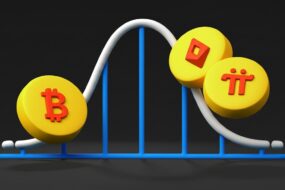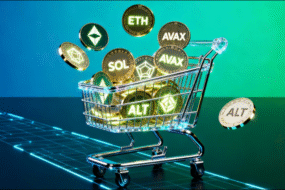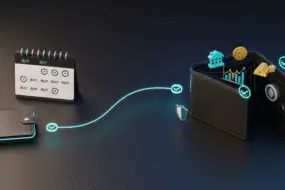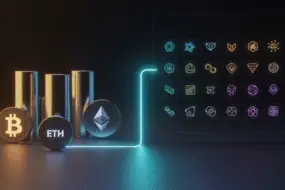
What makes Solana one of the most resilient blockchain platforms of our time? Why did a blockchain that was once written off after the FTX collapse roar back to become a powerhouse in 2025? And what exactly makes Solana so unique compared to Ethereum or Avalanche? Let’s explore the story of Solana from genesis to 2025 – a tale of innovation, setbacks, and an uncompromising vision.
Key Takeaways
- Solana’s history is a tale of innovation, crisis, and comeback.
- After the FTX collapse, Solana pivoted to real utility with mobile integration and scalable tech.
- Solana’s architecture positions it as a serious contender for the future of blockchain platforms.
Origins of Solana (2017–2020)

Nowadays, Solana ranks as the 6th largest cryptocurrency, with a market capitalization exceeding $85 billion. But how did this San Diego-born blockchain platform go from a whitepaper about “Proof of History” to becoming the foundation for everything from NFT marketplaces to mobile phones? What lessons did it learn from the devastating FTX collapse, and why are institutional investors now flocking back to what was once written off as dead?
The Vision Behind Solana
In 2017, while most of the cryptocurrency market was obsessing over Bitcoin’s price movements, Anatoly Yakovenko was solving a different problem entirely. Working in San Diego with a background from Qualcomm and Dropbox, he saw firsthand how traditional distributed systems struggled with one fundamental challenge: time.
Every blockchain faced the same bottleneck. From Bitcoin to Ethereum, networks had to wait for nodes to agree on when transactions occurred. This coordination dance limited throughput to a handful of transactions per second, nowhere near what global finance demanded. But what if there was a way to create a cryptographic clock that could prove the passage of time without requiring constant communication between validators?
Anatoly Yakovenko & the Whitepaper
The breakthrough came in November 2017 when Yakovenko published his whitepaper introducing Proof of History. This wasn’t just another consensus mechanism – it was a paradigm shift that would make Solana unique among blockchain platforms. Working alongside co-founders Greg Fitzgerald, Stephen Akridge, and Raj Gokal, the team envisioned a network capable of handling the transaction volume of traditional financial systems while maintaining the security and decentralization crypto promised.
Their ambition was heroic: create a blockchain that could process 65,000 transactions per second without sacrificing decentralization. In a world where Ethereum struggled with 15 transactions per second and Bitcoin managed 7, this seemed impossible. Yet the math was sound, and the vision was clear.
Proof-of-History and the Innovation Behind the Tech

Proof of History revolutionized blockchain architecture by creating a verifiable delay function – essentially a cryptographic timestamp that proves events happened in a specific sequence. Think of it as a blockchain’s internal clock that eliminates the need for validators to communicate about timing for every single transaction.
This innovation enabled Solana’s architecture to implement additional optimizations: parallel transaction processing, where thousands of smart contracts could execute simultaneously across different processor cores. This drastically improved throughput, allowing Solana’s architecture to process over 65,000 transactions per second at peak efficiency. Combined with faster block times and a more efficient consensus mechanism called Tower BFT, Solana’s network could achieve the kind of throughput that made complex decentralized applications practical for the first time.
The founding team’s vision extended beyond just speed. They wanted to build a censorship-resistant platform where developers could create applications with user experiences comparable to traditional web services. This meant solving not just throughput, but also keeping transaction fees low and maintaining network stability under heavy load.
The Breakout Years (2021–2022)

Solana vs Ethereum: The “ETH Killer” Narrative
Solana vs Ethereum became a popular debate in the crypto world. With lower transaction fees, faster confirmation times, and a developer-friendly ecosystem, Solana quickly earned the title of “Ethereum Killer.” It was not just a tagline – it was backed by real metrics and developer activity.
By 2021, Ethereum’s gas fees hit $100+ per transaction, pushing users toward alternatives. Solana, with its $0.01 fees and instant settlements, became the top contender.
This period saw Solana’s SOL token price skyrocket from under $4 to over $260, representing a 6,000% gain that captured global attention. More importantly, the ecosystem was growing exponentially, with developers migrating from Ethereum and new projects launching exclusively on Solana.
Ecosystem Explosion – NFTs, DeFi, and Gaming
Solana’s ecosystem exploded in 2021. The launch of the Degenerate Ape NFT collection pushed SOL’s price to an all-time high above $60, and by September, it hit $216. Non-fungible tokens (NFTs) like Solana Monkey sold for millions, with secondary sales hitting $500 million between August and November.
Decentralized finance (DeFi) platforms like Serum, backed by FTX, and NFT marketplaces like Magic Eden flourished. Gaming projects like Star Atlas also gained traction, showcasing Solana’s versatility.
With over 5,100 projects by 2022, Solana was a hub for innovation. What was fueling this frenzy? Speed, low costs, and a passionate community.
Solana Ventures and Strategic Investments
Solana’s growth wasn’t just organic. Solana Ventures, backed by the Solana Foundation, poured funds into promising projects. Through public and private sales, the ecosystem attracted both retail investors and institutional interest, positioning itself as a competitive force in the cryptocurrency market.
High-profile investors like Andreessen Horowitz and Alameda Research (tied to FTX) fueled the ecosystem’s expansion. The Solana token (SOL) distribution included 16.23% for an initial seed sale at $0.04 in April 2018, yielding a staggering 5,400X ROI by 2021’s peak.
The Fall and Rebirth (2022–2023)

But with great hype came great risks. Was Solana’s rapid rise sustainable?
FTX Collapse and the Price Crash
November 2022 was a nightmare for Solana. Everything changed with the FTX collapse. Solana’s close ties with Sam Bankman-Fried’s empire triggered a severe price crash.
FTX and Alameda held $982 million in SOL tokens, and their sell-off caused SOL’s price to plummet 40% in a single day, dropping from $258 to under $15 by year’s end. Solana’s market cap fell from $75 billion to $3 billion. Network outages, like a six-hour downtime in October 2022, didn’t help. The Solana price dropped by over 95%, and critics proclaimed Solana’s death.
But something remarkable happened during this crisis. Instead of abandoning ship, Solana’s core community doubled down. Developers kept building, validators kept the network running, and users continued transacting. The technology that had attracted people to Solana – the speed, the low costs, the innovation – remained intact despite the financial chaos.
Community Resilience and the Pivot to Real Utility

The crypto winter of 2022-2023 forced Solana’s ecosystem to mature rapidly. Without easy funding and speculative bubbles, projects had to deliver actual utility to survive. This pressure created a stronger, more sustainable foundation for long-term growth.
DeFi protocols focused on real yield and sustainable tokenomics rather than unsustainable rewards. NFT projects shifted from pure speculation to utility-driven communities. Gaming developers continued building, knowing that Solana’s technical advantages would matter more than token prices in the long run.
The developer community proved particularly resilient. Hackathons continued drawing thousands of participants. Open-source contributions accelerated. New projects launched despite market conditions, betting on Solana’s technical superiority and community strength. By mid-2023, SOL’s price climbed to $23, and NFT sales hit $158 million in January alone.
Solana Phone and Real-World Integrations

In April 2023, Solana Mobile launched the Saga, an Android smartphone with preinstalled Solana-based dApps. Despite mixed reviews and a $1,000 price tag, the Saga signaled Solana’s ambition to bridge blockchain and real-world use. Solana Pay also gained traction, with Visa adding support for USDC payments on Solana in September 2023.
Initial sales of Saga were modest, but the phone found unexpected success through an airdrop of BONK tokens that made early buyers profitable. More importantly, it demonstrated Solana’s commitment to consumer applications and real-world utility beyond purely financial use cases.
Scaling in Silence (2024)

Firedancer, Validator Upgrades & Throughput
While other chains focused on marketing, Solana focused on tech. Firedancer, a new validator client by Jump Crypto, improved network stability and opened the door for greater scalability. Upgrades like QUIC and stake-weighted QoS tackled congestion, while Solang, a new compiler, let Ethereum developers deploy Solidity contracts on Solana. With 1,300 validators and plans to double blockspace, Solana’s network was stronger than ever. Was this the year Solana proved its critics wrong?
Rise of Solana-native Apps
Solana’s ecosystem matured with projects like Phantom Wallet, which hit second place in Apple’s US App Store utilities category, and Mad Lads, an NFT collection tied to Backpack. Memecoins like PENGU, launched with a $1.5 billion airdrop, and DeFi platforms like Jupiter thrived.
Solana processed over 100 million transactions daily from 500,000 active wallets. The network’s low fees and speed made it a retail investor favorite.
Institutional Interest Returns
Institutional confidence returned in 2024. Solana’s market cap hit $71.6 billion by August, and DeFi total value locked (TVL) soared 750% to $4.4 billion. Firms like Franklin Templeton and Sol Strategies announced major Solana-focused initiatives, including a $1 billion raise for investment flexibility.
Solana in 2025 – Where We Are Now

Market Cap, Ecosystem Maturity, and Key Metrics
By 2025, Solana’s market cap has re-entered the top three in the cryptocurrency space. The circulating supply of SOL is more transparent, and total supply is tightly monitored. With over 3,000 active projects and one of the highest daily transaction volumes, Solana is no longer the underdog.
How Solana Positioned Itself Post-Ethereum ETF
Following the approval of the Ethereum ETF, many expected Ethereum to dominate. But Solana’s value proposition – faster block times, state compression, and seamless mobile integrations – kept attracting users. Unlike Ethereum, Solana doesn’t rely on L2s, giving it a cleaner user experience.
Developer Community and L2 Positioning
Rather than building L2s, Solana’s approach has been to scale L1 directly. This attracted more developers looking for simpler stack requirements and predictable transaction fees. The Solana Foundation continued to sponsor hackathons and grants, ensuring a vibrant dev scene.
What’s Next? Predictions and Narratives

Will Solana Challenge Traditional Finance?
Could Solana disrupt centralized payment systems or challenge fiat currency infrastructure? With high transaction throughput and near-zero fees, it supports use cases from cross-border remittances to micropayments – Visa, Stripe, and PayPal are already experimenting on Solana. As meme coins, NFTs, and institutional-grade apps coexist on a single platform, the dream isn’t far off.
Regulatory Outlook for L1 Chains
The regulatory climate will shape the future. Solana’s transparent governance and open-source model put it in a strong position. Collaborations with regulators and clear compliance tools are being developed by Solana Labs.
Multichain Future or Solana-Only UX?
Solana’s bridges (e.g., Wormhole) and cross-chain tools hint at a multichain future, but its user experience (UX) is so seamless that some predict a Solana-only ecosystem. With memecoins, NFTs, and dApps thriving, Solana’s community believes it can dominate retail crypto.
Final Thoughts
The story of Solana proves that in blockchain, as in life, resilience matters more than perfection. From a whitepaper about timestamps to a $85 billion ecosystem challenging traditional finance, Solana’s path demonstrates what’s possible when technical innovation meets community determination.
Will it overtake Ethereum? Maybe. But one thing is certain: this story is far from over.
FAQs
Q1. What is the Solana Network and how does it work?
Solana is a high-speed, Layer 1 blockchain that processes thousands of transactions per second thanks to its unique Proof-of-History consensus mechanism. It’s designed for scalability, low fees, and decentralization.
Q2. What distinguishes the Solana blockchain from other platforms?
Solana uses Proof-of-History, allowing ultra-fast transaction speeds and low fees, making it one of the most efficient blockchains today.
Q3. What is the Solana Mobile Stack?
It’s a toolkit that lets developers build mobile apps with blockchain features. It powers the Solana Phone, enabling wallets and dApps on mobile.
Q4. Why is Solana considered a scalable blockchain?
Solana achieves scalability by combining Proof-of-History with parallel processing and a single-layer design. Unlike networks that fragment activity across L2s, Solana keeps everything on one fast, low-latency chain.
Q5. Why did Solana’s price drop in 2022?
Solana dropped due to its ties to the FTX collapse, but it recovered thanks to its active community and developers.
Q6. How do validator nodes support Solana?
Validator nodes confirm transactions and secure the network, ensuring high speed, reliability, and decentralization.
Q7. Is Solana ecosystem a good crypto investment in 2025?
With its rising market cap, growing ecosystem, and tech-focused roadmap, Solana presents an attractive investment for those bullish on high-performance blockchains. Still, investors should do their own research.
Q8. What are meme coins on Solana and are they important?
Meme coins like BONK and PENGU exploded in popularity on Solana due to low transaction costs and community-driven momentum. They help onboard retail users and showcase Solana’s throughput.









